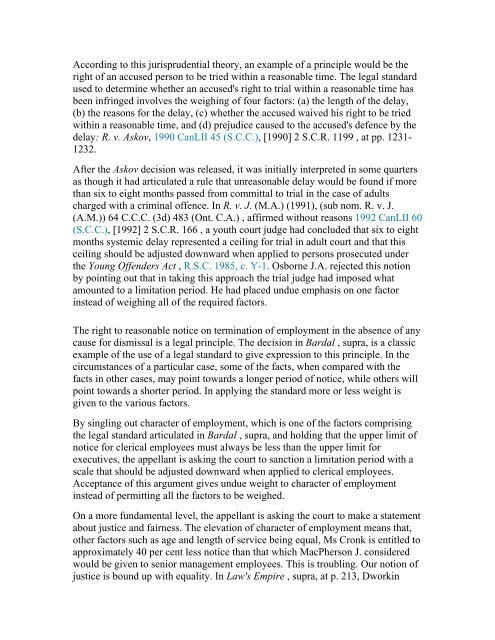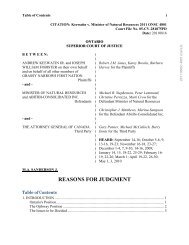Cronk v. Canadian General Insurance Co., 1995 CanLII 814 (ON CA)
Cronk v. Canadian General Insurance Co., 1995 CanLII 814 (ON CA)
Cronk v. Canadian General Insurance Co., 1995 CanLII 814 (ON CA)
Create successful ePaper yourself
Turn your PDF publications into a flip-book with our unique Google optimized e-Paper software.
According to this jurisprudential theory, an example of a principle would be the<br />
right of an accused person to be tried within a reasonable time. The legal standard<br />
used to determine whether an accused's right to trial within a reasonable time has<br />
been infringed involves the weighing of four factors: (a) the length of the delay,<br />
(b) the reasons for the delay, (c) whether the accused waived his right to be tried<br />
within a reasonable time, and (d) prejudice caused to the accused's defence by the<br />
delay: R. v. Askov, 1990 <strong>CanLII</strong> 45 (S.C.C.), [1990] 2 S.C.R. 1199 , at pp. 1231-<br />
1232.<br />
After the Askov decision was released, it was initially interpreted in some quarters<br />
as though it had articulated a rule that unreasonable delay would be found if more<br />
than six to eight months passed from committal to trial in the case of adults<br />
charged with a criminal offence. In R. v. J. (M.A.) (1991), (sub nom. R. v. J.<br />
(A.M.)) 64 C.C.C. (3d) 483 (Ont. C.A.) , affirmed without reasons 1992 <strong>CanLII</strong> 60<br />
(S.C.C.), [1992] 2 S.C.R. 166 , a youth court judge had concluded that six to eight<br />
months systemic delay represented a ceiling for trial in adult court and that this<br />
ceiling should be adjusted downward when applied to persons prosecuted under<br />
the Young Offenders Act , R.S.C. 1985, c. Y-1. Osborne J.A. rejected this notion<br />
by pointing out that in taking this approach the trial judge had imposed what<br />
amounted to a limitation period. He had placed undue emphasis on one factor<br />
instead of weighing all of the required factors.<br />
The right to reasonable notice on termination of employment in the absence of any<br />
cause for dismissal is a legal principle. The decision in Bardal , supra, is a classic<br />
example of the use of a legal standard to give expression to this principle. In the<br />
circumstances of a particular case, some of the facts, when compared with the<br />
facts in other cases, may point towards a longer period of notice, while others will<br />
point towards a shorter period. In applying the standard more or less weight is<br />
given to the various factors.<br />
By singling out character of employment, which is one of the factors comprising<br />
the legal standard articulated in Bardal , supra, and holding that the upper limit of<br />
notice for clerical employees must always be less than the upper limit for<br />
executives, the appellant is asking the court to sanction a limitation period with a<br />
scale that should be adjusted downward when applied to clerical employees.<br />
Acceptance of this argument gives undue weight to character of employment<br />
instead of permitting all the factors to be weighed.<br />
On a more fundamental level, the appellant is asking the court to make a statement<br />
about justice and fairness. The elevation of character of employment means that,<br />
other factors such as age and length of service being equal, Ms <strong>Cronk</strong> is entitled to<br />
approximately 40 per cent less notice than that which MacPherson J. considered<br />
would be given to senior management employees. This is troubling. Our notion of<br />
justice is bound up with equality. In Law's Empire , supra, at p. 213, Dworkin
















